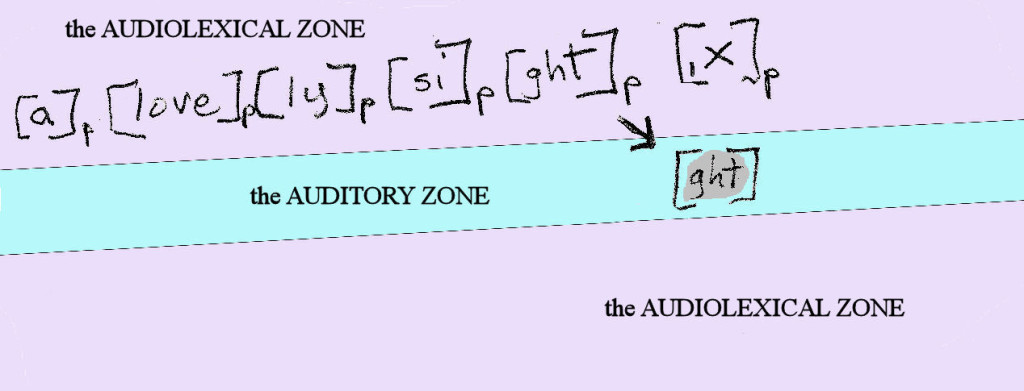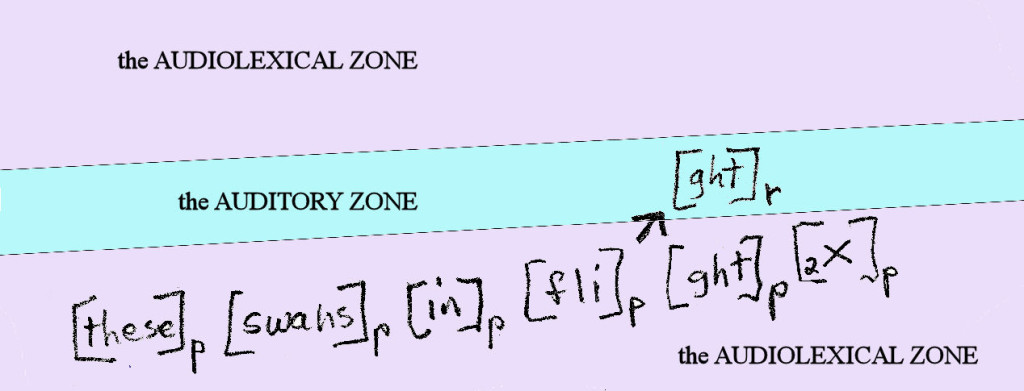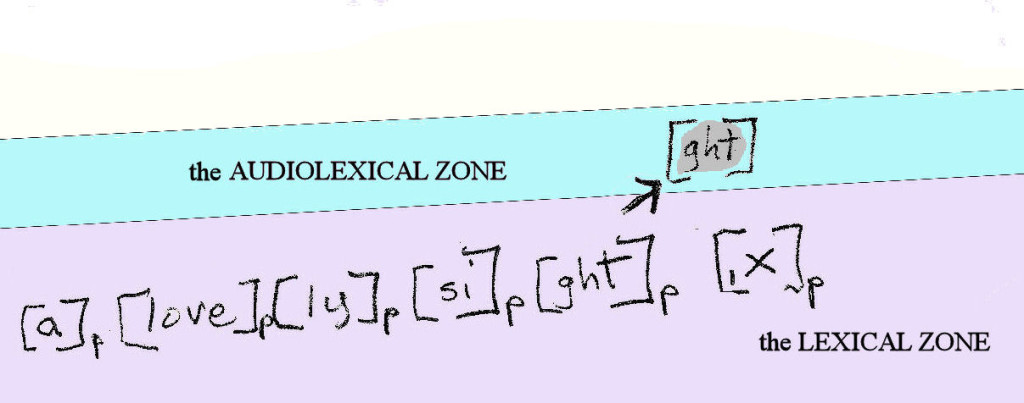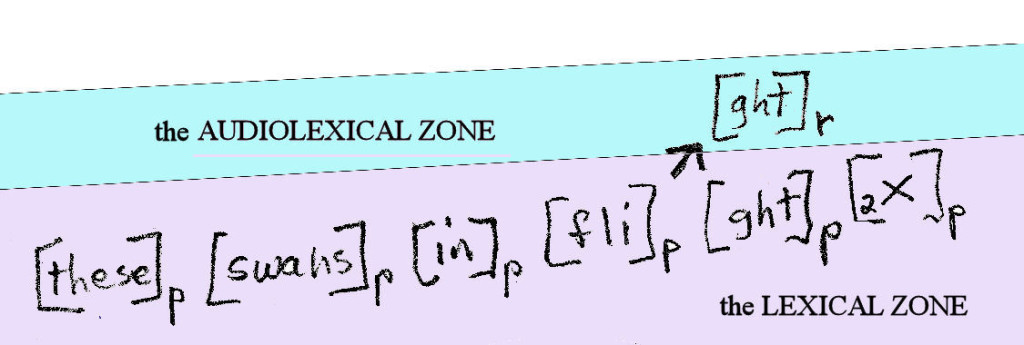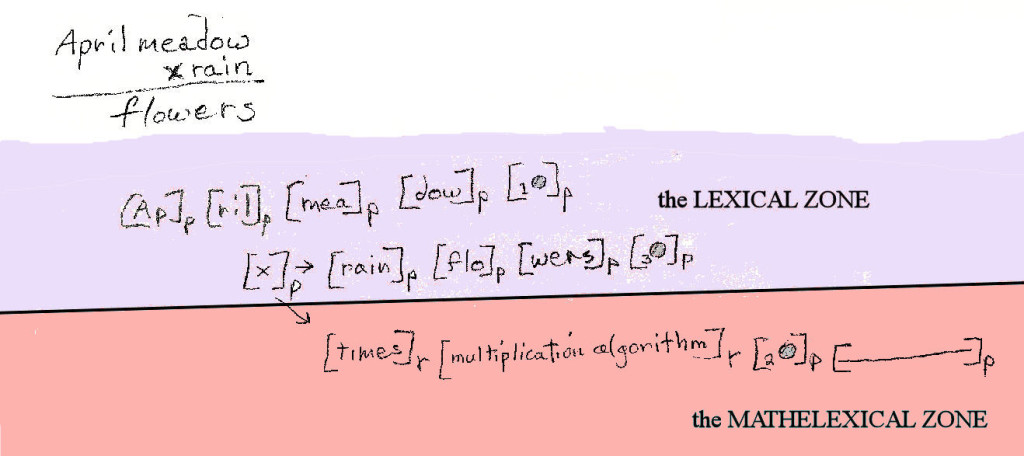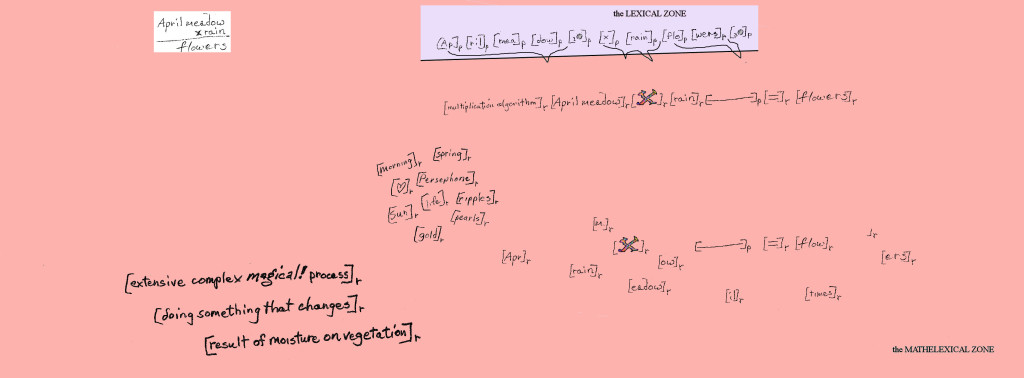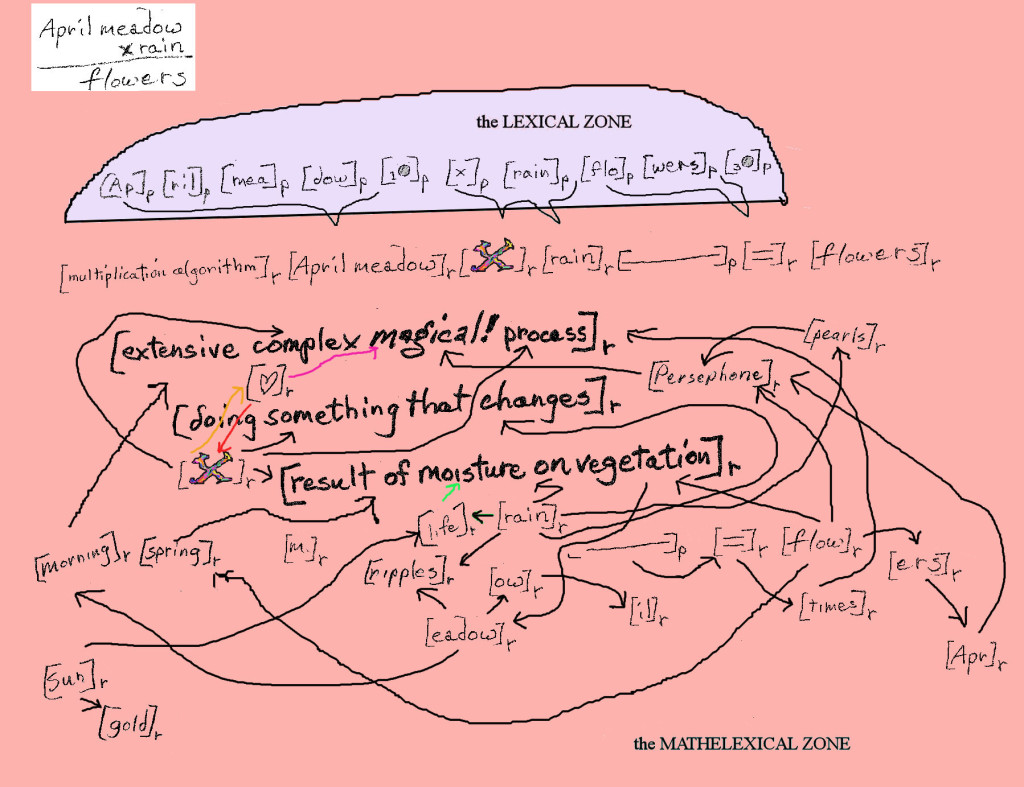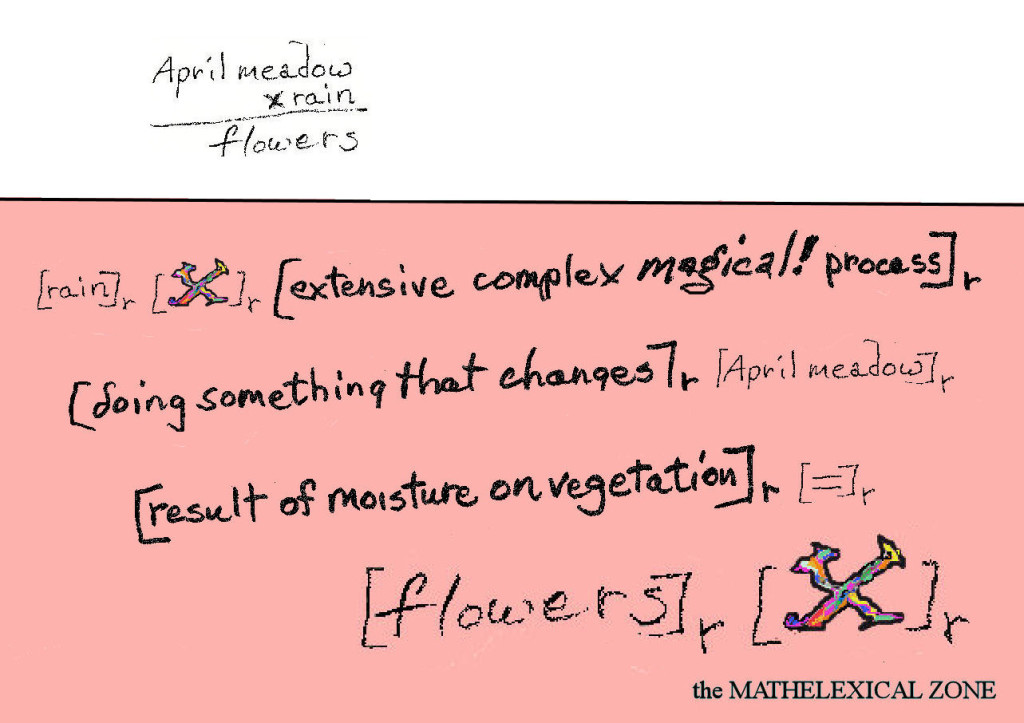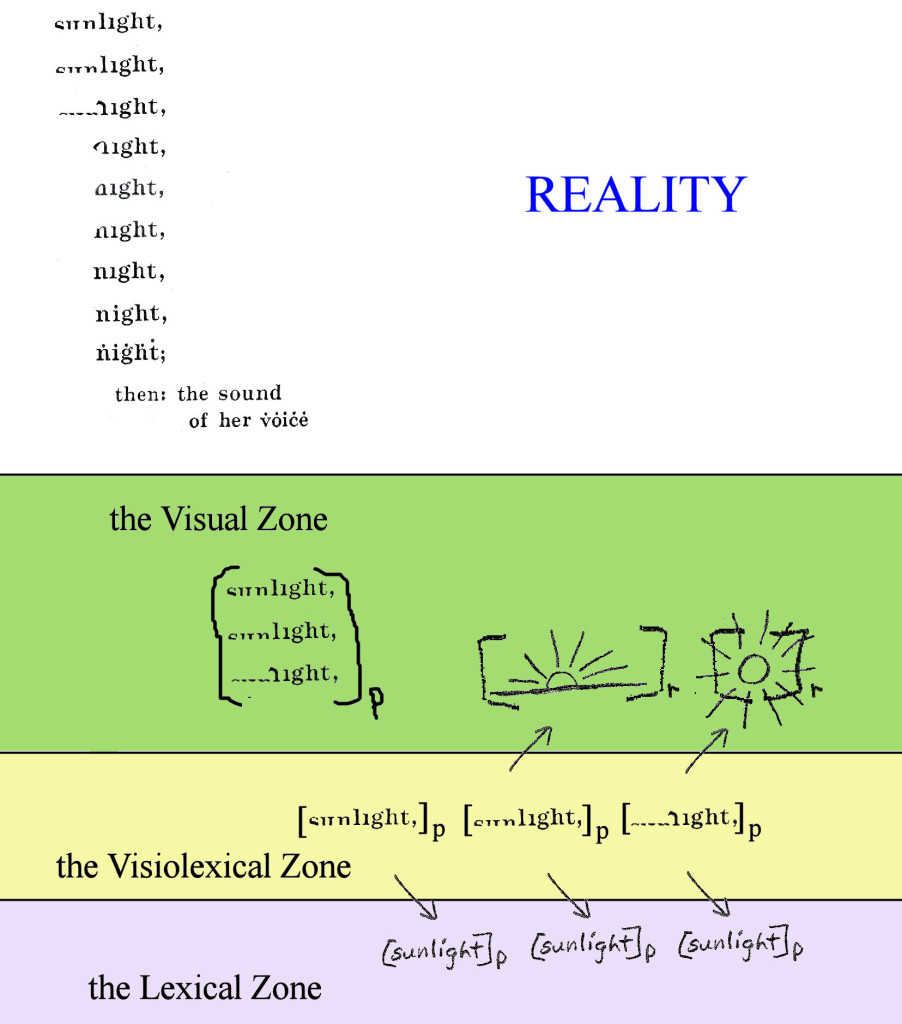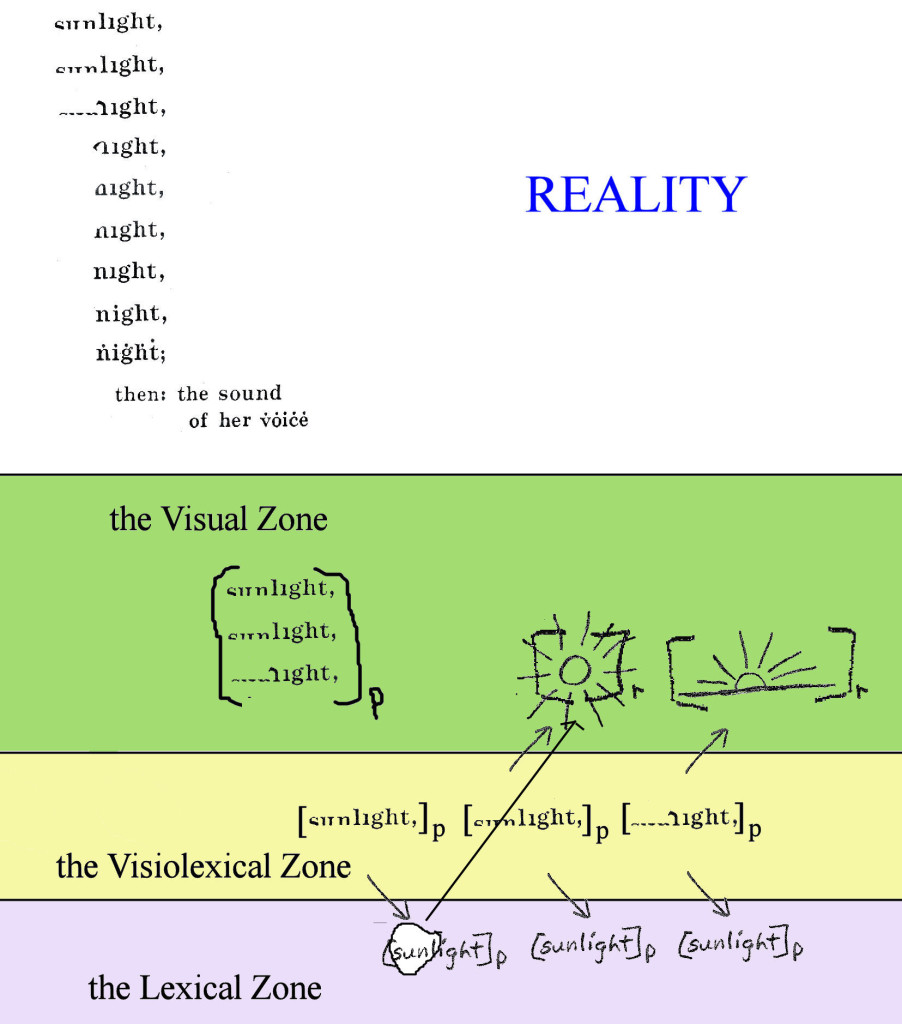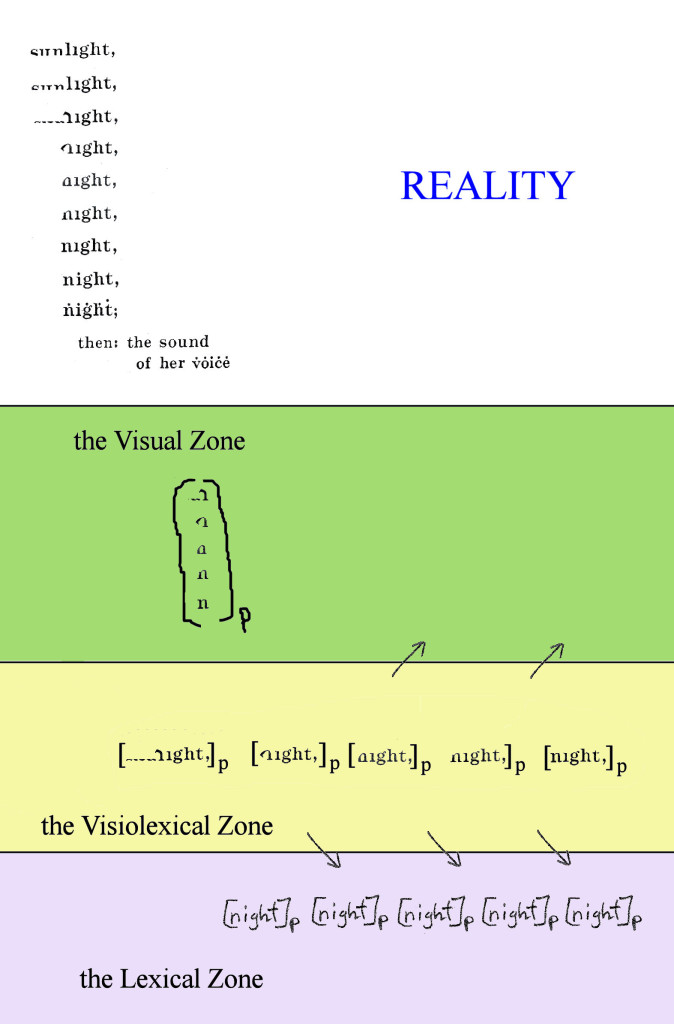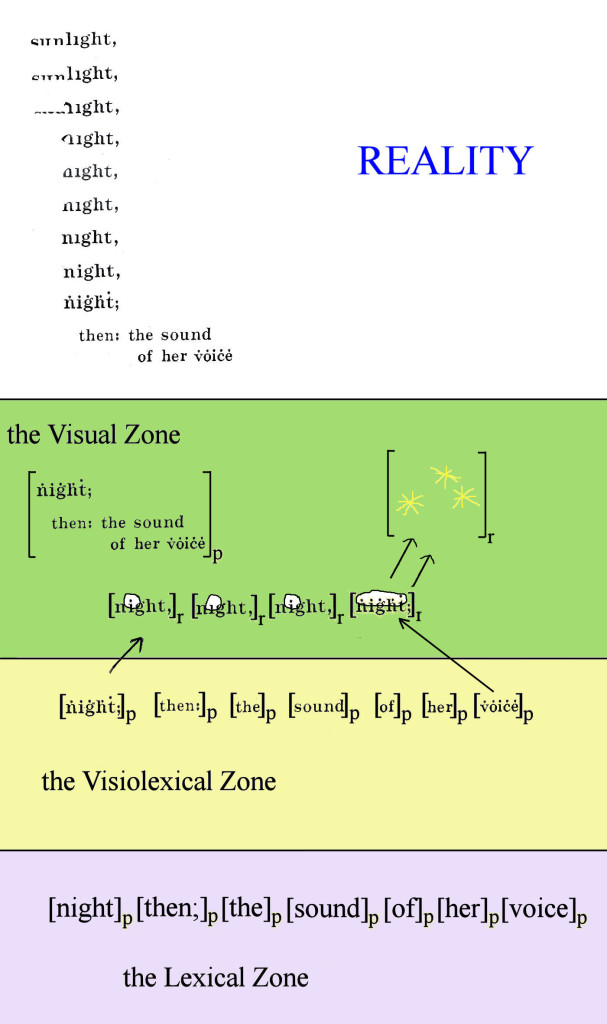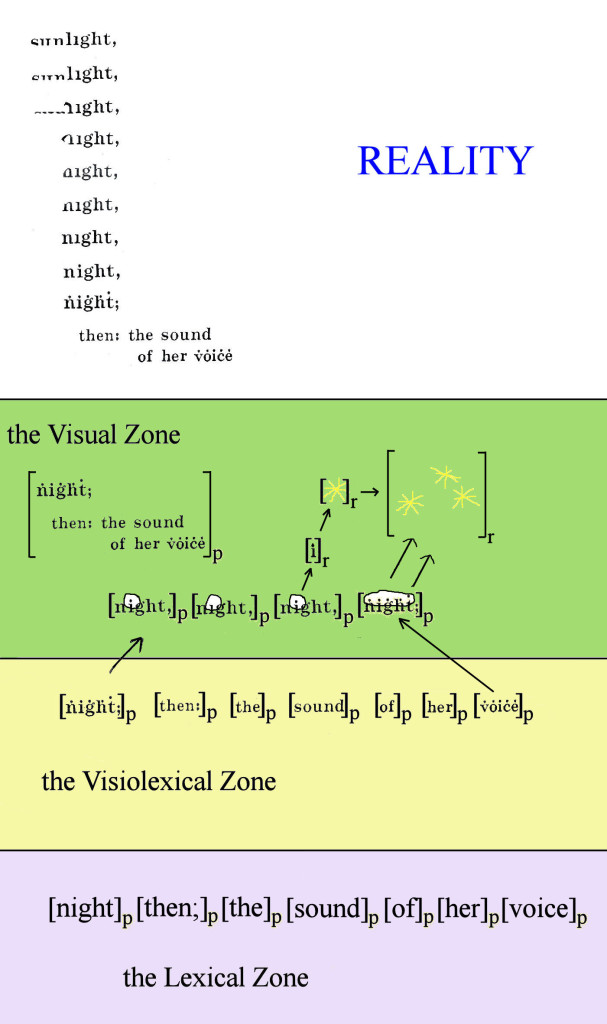Exploration of Manywhere-at-Once
Entry 1071 — The Errntlexeme
April 12th, 2013
My latest coinage is pronounced “AIRNT lehks eem.” I’m rather proud of the “errnt,” which is intended to suggest “errant,” because it’s the first syllable I’ve used in one of my coinages that’s a non-standard lexical fusion unit, as far as I know. My “rigidnik,” for instance, is just the standard word “rigid” plus the stand suffix, “nik.” Lexeme is just the standard word for, uh, “word”–as far as I know.
Definition? “A word employed in a poem with the aim of derailing the poem’s, uh, ‘linguflow,’ where it occurs.” A bentword, as I think I previously called it. Oh, make that “A word employed in a poem with the aim of derailing the poem’s ‘linguflow,’ where it occurs long enough to cause the pocipient to experience frustration. It is an effective errntlexeme for a given pocipient to the degree that it is resolvable, for him–and, in my philosophy, objectively effective to the degree that it is resolvable for the majority of intelligent, knowledgeable pocipients.
Its purpose beyond derailment is to cause aesthetic pleasure (not, I feel I must add, to keep the “truth” of a poem’s didactic message from causing hostility as it seems to me now that Emily Dickinson considered the purpose of slant wording after long thinking–because having forgotten the context of her use of “tell it slant”–she thought of it the way I think of errntlexeme). But a good errntlexeme will slant away from a pocipient’s expectations to result, if resolved, in the familiar encountered unexpectedly that I consider the sole cause of aesthetic pleasure. Not that such pleasure may not, and probably will be, accompanied by reflexive sensual or other pleasure.
I’m thinking now that aesthetic pleasure, which I’ve always had a tough time pinning down, is entirely reductiptual–which is to say it occurs only in the conceptual part of the brain. That’s aesthetic pleasure according to my aesthetics. The full pleasure of a successful poem includes other pleasures.
More on this in due course. Right now, what I hope to do in the next few days, is go back to my discussion of Manywhere-at-Once to analyze how an errntlexeme works in a poem. I should have started with that, but didn’t think of it. It’s the simplest poetic device, and much undervalued, especially by conventional poets.
Before posting this entry, I want to announce another coinage: “cerebralane,” a replacement for what I was calling a “knowleculation.”
While making announcements, here’s another: yesterday I updated my archive here of published Small Press Review columns in this blog’s “Pages” section. The most recent of these is a review of The Last Vispo Anthology.
Entry 1053 — Manywhere-at-Once, the Metaphor
Monday, March 25th, 2013
Recently I’ve run into people who seem not to come close to understanding Manywhere-at-Once. To try to make clear what I mean by it, and it is central to my poetics, I’m going to turn to the following sentence, “in the battle he was a ferocious tiger.” Here a tiger is used as a metaphor for a man in a battle. Let us assume that the sentence is being read by a mentally healthy, intelligent reader who has never encountered the metaphor before. I claim that it will send him to two unconnected places in his brain. To Manywhere-at-Once, in other words. The illustrations below roughly indicate the simpler details of what happens:
Note: “r” stands for “retroceptual” or “having to do with remembered data”; “p” stands for “perceptual” or “having to do with perceived data”; and “c” stands for “combiceptual” or “having to do with data partially remembered and partially perceived.” In the diagram at the top, a person hearing the sentence, “In the battle the warrior was a ferocious tiger,” experiences [ferocious], an auditorily-perceived word , then [tiger], another auditorily-perceived word. I assume the sentence will make the person remember the word, “warrior,” or a similar word, because it is strongly suggested by the fact that a “he” who is “in a battle” will be a warrior. It may be something else. Exactly what will depend on the previous related experiences of the person involved and memory mechanisms too complicated to get into here. It will be something, almost surely, if only a vague impression of a human being. It will specifically be something the person involved expected to follow the word, “ferocious,” but not “tiger.”
The perception of the “wrong” word (“tiger”), the errntlexeme, is contradicted by the retroception of the expected word (or near-word, what it is) to cause momentary pain. To enter Manywhere-at-Once will generally cause momentary pain. But if a resolution of the contradiction quickly occurs, the relief experienced will be high pleasurable. In this case, it does: both “tiger” and “warrior” lead quickly to “destroyed” (or some word like that, some word that works, that connects “tiger” and “warrior”). So, the pleasure of resolution. To this is added a feeling of expansion due to the enlargement of experience–instead of just experiencing connotations that would have occurred had “warrior” been spoken rather than”tiger,” one experiences also tiger-connotations.
Now, then, when one next hears to sentence, one still may not be ready to expect “tiger” as part of what “ferocious” leads to, and one will re-experience Manywhere-at-Once. At some point, however, one will experience [tiger] and [warrior] combiceptually, as shown in the lower illustration. From then on one may well experience the two as a pleasurable enriched image-cluster, but no longer be in Manywhere-at-Once.
Oops, that’s not entirely true. If one is absent from the metaphor for long enough a time, one’s “Onewhere-at-Once” may weaken enough for one to re-experience the metaphor freshly. To put it simply, one will forget one’s previous visit to a particular Manywhere-at-Once sufficiently to come back to it as if for the first time.
Entry 1054 — Manywhere-At-Once, the Rhyme
Tuesday, March 26th, 2013
I’m tempted to leave the diagrams shown as sufficient explanation of my theory of rhymes.
Oh, what the heck, I’ll at least partially explain it. First of all, you have to understand that I believe in a sort of platonic form of language–a kind of speech that is not genuinely heard. Absurd? Only slightly. My description was intended to overdo it a bit to be provocative. To heighten your attention. What I believe is that when we listen to someone, we do hear their words, but only audiolexically–which is to say, only enough to identify them as words. The words identified as such go through further processing on their way to the “lexical zone” of the brain shown in violet in the diagrams above. There they cause energy to be stored in appropriate cells in sufficient quantity to activate them. Their activation is what experience lexically. A record of those cells’ activation is at the same time made in cells within what I call the zone’s ”mnemoduct.”
Note: the pieces of sound that words themselves are never get past the ears. What I call “words” in the preceding paragraph are actually ever-changing signals that end up (probably) as chemical neuro-transmitters that tell a cell to tell a person’s consciousness he has encountered a certain word. For simplicity’s sake, I call them words, anyway.
The words involved simultaneously also make their way to the audiolexical zone shown in blue. They will also cause energy to be stored in appropriate cells there but not in sufficient quantity to activate them. The energy will merely prime the cells they are in, which will increase their susceptibility to activation by any further energy they gain.
The reason the audiolexical cells involved are not activated is that the zone will be in a state of low-attention, put there by the brain’s helping the person involved to focus on the words he is hearing by lowering his attention on other zones, and raising it on his lexical zone. Assuming ordinary circumstances, since this will not always happen (according to my theory of knowlecular psychology, as is the case with everything I’m saying here). Listening to a poem as we read it, is another matter, or really concentrating on words we want to memorize. Either will awaken our audiolexical zone.
When we read words, we will (generally) only “sublexically” see them the same way we generally sublexically hear spoken words. The seen words will transmit energy to cells in the visiolexical zone rather than the audiolexical zone. There is also a musculexical zone where our percepts of our own normal and and sublingual speech transmit energy to appropriate cells.
I’m too worn out to go on. See if from what I’ve told you, you can figure out how I think our appreciation of rhymes works! I will come back to it tomorrow, if I’ve recovered from my efforts today.
Entry 1055–Manywhere-at-Once, the Rhyme, 2
Wednesday, March 27th, 2013
Okay, here goes my attempt to give my knowlecular explanation of rhyme-appreciation. In the upper illustration the auditory knowlecule [ght] is carefully differentiated from the audiolexical knowlecule [ght] (a ‘knowlecule” being a “molecule” of knowledge in my theory, as you should all know by now!), and shown highlighted in gray to indicate that it is “primed,” which means that it is partially on the way to being activated because it contains stored . . . neuro-transmission chemicals of the kind that provide cell-activating energy when available in sufficient quantity. The illustration is intended to depict the knowleculation–in this case, an audiolexical one ending in [x]–just created in a given subject’s brain. [x] is whatever connotations knowlicles (final units of knowlecules) [“a lovely sight”] activated along with random “noise”–i.e., random knowlicles that will come alive in every instacon (or moment of consciousness) almost entirely out of context. I include it for completeness, but it is of no importance for my story here.
The lower illustration shows the subject having just heard “these swans in fli–” in the process of experiencing [ght] audiolexically. Of pivotal importance, though, is that he is shown also experiencing [ght] as a retrocept in his auditory zone. This results because the audiolexical knowlecule (or partial knowlecule) [fl] must send a small amount of neuro-transmitter to the primed [ght] in the subject’s auditory zone. Now, this may not be enough for the latter’s activation, but in most cases ought to be, for the auditory [ght] will probably have gotten a bit of activation-causing neuro-transmitter from the expectation of rhyme-occurence he, like most people, would have learned that poems of the kind he is hearing cause. Be that as it may, I’m assuming the second shot of neuro-transmitter causes the activation of the subject’s auditory [ght]. This puts him in a Manywhere-at-Once because he will experience a [ght] in each of two separate places.
It’s all ridiculously simple. According to my theory of pain and pleasure, pleasure is a matter (for the most part) of the number of neuro-transmitters an instacon’s releases that succeed in causing cellular activation compared to number that fail to do this. Ordinarily, the neuro-transmitters [fli]‘s sent to the auditory zone would not activate anything, so would keep the audiolexical [fl] from causing much, if any, pleasure. Not so, this time.
There are many other complexities involved that I won’t get into here to avoid confusion. It should be remembered that what I’ve said is a simplification. I stand by its being close enough to what will happen if my theory is not too wrong. I further contend that even if my theory is 90% hooey (no, my good friends, it is nowhere near 100% hooey), my account of rhyme-appreciation is better than any other one out there. And it applies, too, to all the varieties (nearly) of what I call “melodation”–to wit, alliteration, consonance, etc. ”Nearly,” because it does not account for the pleasure of euphony. That, and perhaps others, is due to our innate predisposition to derive pleasure from certain sounds like “ah.” We may also have such a predisposition to enjoy any repeated verbal sound. Only when neurophysiological lab technicians have the means to test my ideas, and they eventually will (if they don’t already), will we know how valid they are.
Yes, they are readily falsifiable. They also break no long-accepted laws of science. Hence, they are scientific.
Note, what I’m calling the auditory zone could probably more aptly be called the lexical-auditory association area.
Entry 1056 — MatO, Review & Corrections
Thursday, March 28th, 2013
The first two illustrations show the creation of the metaphormation of “tiger” as a metaphor for “warrior” in the brain, according to my knowlecular theory of psychology. Concerning this, I have a minor correction: I previously said the part of the brain involved was the audiolexical zone. I now say it’s the lexical zone.
I have little to add to my knowlecular treatment of rhyme-formation except to note that the ext involved opens a knowleculation in the lexical, not the audiolexical zone, and that it is the latter, not the auditory zone in which the rhyme is experienced as a sound. Actually, the audiolexical zone is part of the auditory zone; it’s where in that zone lexical sounds only can be heard. A text will always in normal circumstances cause a lexical knowleculation to be laid down in the lexical zone and, at the same time, the same knowleculation to be primed but not activated in the audiolexical zone. One advantage of this evolutionarily, I might note, is that it gives spoken material a better chance of being remembered shortly after a person’s exposure to it than most competing data.
What follows is my illustration of the first two steps in the creation of a mathephormation (i.e., a knowleculation containing mathematical metaphors). The stimulus is the multiplication example at the top left in the upper illustration. It is depicted in the upper illustration causing a more or less standard lexical knowleculation to be laid down in the lexical zone. Along the way, however, the mathematical symbols generate a fragmentary mathematical knowleculation which includes the algorithm for multiplication.
This, as the lower illustration indicates, allows for the creation of the sort of mathematical sentence containing metaphors that I contend effective mathexpressive poetry will result it, with pleasure for those experiencing them.
What happens, to simplify to a ridiculously great degree, is that the multiplication algorithm the person has long ago learned (one hopes), will force the formation of a knowleculation beginning with [April meadow], which is the muliplicand. To this is added . . . and here my illustration crumbles, so I have to fix it. But it still should give you an idea of what happens. The main thing it does not give you an idea of is the sense of the logic of the mathephors generated. Tomorrow I hope to have a corrected version of the lower illustration and a third illustration with which I try to show why a good mathexpressive poem can provide significant aesthetic pleasure.
Entry 1057 — Manywhere-at-Once, the Mathephor
Friday, March 29th, 2013
I’m not in my null zone, for I feel pretty chipper, but I’m turble tired. So just a few more illustrations of how a mathematical metaphor (“mathephor”) develops in the brain. For those of you who have given my previous lessons the proper amount of attention, my illustrations should be enough, particularly if you remember what accommodance is, since it is what ultimately allows for the creation and appreciation of metaphors of any kind, although a higher level of it is probably needed for the creation and appreciation of mathephors.
Note that the metaphor reaches its highpoint in the mathelexical zone. Not shown is the continued presence of related words as pure text in the lexical zone. Hence, the person involved will experience Manywhere-at-Once. More on this in tomorrow’s entry, I hope–then on to the visiophor.
Entry 1058 — Poetry Appreciation Accommodance
Saturday, March 30th, 2013
(Note: I suddenly realized that I’ve been treating my texts like they are world class poems, or excerpts of world-class poems. What I’m doing, if it isn’t clear, is showing how a very simple example of a use of metaphor in an attempt at poetry will work for someone who appreciates it–someone, in other words, who is at its level, as we all were once at the level of nursery rhymes.)
What’s going on in the illustration above is accommodance at work. It could just as well be called “dipping into the subconscious.” I got the idea for it from Aldous Huxley when he was discussing his experiences with drugs—hallucinogenic drugs, I believe. All he said was that they opened a door that admitted data we normally blocked out. I was considering the possible effect of variable cerebral energy levels at the time—being sure, as I still am, that everything we do mentally depends on energy-requiring mechanisms. Not being well-read in formal psychology I’m not sure those in the field with the proper credentials believe that, but I think most of them do. It’s the mystics who don’t.
Anyway, for some reason, I jumped into the idea that “blocking” the entrance of data might require energy pushing the involved door shut. Hence, a weakening of energy might be what allows those doors to swing open. Other simple ideas of mine in development lead me to conclude that a sense of wrongness can cause a lowering of cerebral energy which causes something to happen somewhat like what Huxley described, except much less dramatic.
To put it most simply, what happens (according to knowlecular psychology) is that a person’s normal tendency to find his way from his ongoing experiences into habitual knowleculations is weakened by a lowering of the energy needed for it. The person’s ability to remember is weakened which, oddly, increases his memories (although it may take a few moments before it does). One of the things that must be understood is that normally one goes from one strongly-remembered understanding of what is going on in one’s life to another—because they have become familiar, something that will not usually happen if they are defective. Hence, if it rains, we remember previous times when it rained and how we avoided getting wet, and open our umbrellas, or run for shelter. That’s all there is to it.
If a person starts to open an umbrella and it explodes (harmlessly), the experience will be unexpected because unfamiliar—radically unfamiliar. One will become appropriately stupid, in effect, due to a decrease in cerebral energy due to his accommodance. He will have no remembered understandings to draw on. He will still try weakly to find memories that pertain to his circumstance, but activate very few. At the same time, much of his cerebral energy will be transmitted to varied memories that will not become active but will become primed to become active. Bits and pieces of memories primed before the explosion may be randomly activated by the environment, which will be able to activate more percepts than it had because of lack of competition from retroceptual activation. Eventually, he will remember recent events, but not necessarily in order (which will enhance their ability to re-order themselves effectively, although they will most often re-order themselves counter-productively—which won’t matter much, usually, due to the brain’s ability to recognize their flawedness and ignore them.)
Finally, sometimes during one’s first reflection on a poetic passage with a metaphor like the one under discussion here, enough of the . . . accommoflow? will clump into a resolution or partial resolution. That will cause one’s accelerance to come into play, strongly activating the new understanding (or, too many times, the potential new understanding that isn’t). And one will have resolved his frustration—or realized he hadn’t, which will turn on his accommodance again.
The process could take a week or more in the case of a poem. Ergo: some poems need to be read many times, and reflected on before they make sense. One can’t expect to enjoy a dramatically new technique like a mathephor as easily and quickly as one can enjoy a rhyme.
Now we know that the above, shown again, depicts something I’m tentatively calling an accommoflow. A very simplified one. With a focus on the part of it in the mathelexical zone although much will be going on importantly at the same time in the lexical zone, and probably in both the visiolexical and audilexical zones. In the best cases, important mental activity will be occurring in non-lexical zones, too—where we feel a moment of some long ago spring just after a shower, say.
Crucial to the effectiveness of the mathephor here, is the colored x, which is my symbol for everything multiplication is, everything that makes it much more for those sensitive to it than a mechanical switch (which it certainly also is).
Ooops, I see I left out the importance of the multiplication algorithm, which is really the primary agent in the creation of the mathephor because (I claim) it will have been strongly activated before the “explosion” occurred by both the multiplication sign (“x”) and the line under the second term. Moreover, it will be a very strong habitual knowleculation, so able to do more even when the cerebral energy available is low than most other data. It will cause a person to find a multiplier and a multiplicand and then use the logic of multiplication he should have learned to determine why it makes sense for the product of the two to be “flowers.” Eventually, understandings like the three shown in darker ink must occur if the mathephor has any chance of being a success.
The above depicts a successful resolution of the knowlexplosion. A multiplication serves as a metaphor for the transformation of a meadow/ the coming of spring/ the birth of flowers, all of these with vivid connotations that will be activated by the energizing effects of the resolution. I would add that there are “under-metaphors” present to the sensitive aesthcipient—for me, one is the metaphor of spring as some kind of machine like a long division “machine” churning out beauty from ordinary constituents.
It is important to note–or am I re-noting it?—that the resolution of this particular knowlexplosion will occur in different parts of the mathelexical zone while at the same time many of the knowlecules involved with be activated in the lexical zone—[flowers], for instance. I fall goes as well as it sometimes can, remembered images of flowers, flower-smells, pleasant dampness and other sensual knowlecules will enter the final experience.
Apologies my not articulating all this very well. It’s not a first draft, either—more like a fiftieth draft. Each one is saying more, but remaining less coherent than I’d like.
Entry 1060 — Surprise Quiz on the Visiophor
Monday, April 1st, 2013
Okay, class, it’s time to find out how much you’ve learned about . . . Manywhere-at-Once. You have the rest of the day to describe the visiophor in the beginning of the poem (my “Nocturne”) and how it works according to knowlecular psychology. E.mail me your papers by seven o’clock tomorrow. They will be graded!
Entry 1061 — A Mistake
Tuesday, April 2nd, 2013
What happened? Only 657 of you turned in papers. Fortunately for the rest of you, I’m only counting it ten percent of your grade for the term. But you’ll now have to work pretty hard for a C, and you no longer have a chance at an A.
Now for a quick run-through of the main points you should have made in your paper, though I’m afraid only four of you got them all.
1. The subject encountering the poem sees it as shown in “Reality.” In most cases he will scan it from top down.
2. He will experience its first three images as the perceptual stack in his visual zone shown over a period of three instacons.
3. An instacon or two later, his visual zone will start a knowleculation in his visiolexical zone. It will consist of the images in the visual zone “grammaticalized,” or put in a line, one after the other, because (and it’s important that you mentioned this, the images sufficiently suggest words to the subject due to his familiarity with the written word. (Due, more accurately, to precerebral mechanisms in the brain that have been trained to detect and strain out visual data that seem textual from everything coming in from the eye, but we have yet discussed that in class, so you needn’t have mentioned it in your paper. I bring it up only to make some of you who are feeling confident about fully understanding this phase of knowlecular linguistics that we are so far dealing with it at an extremely superficial level.)
4. The knowleculation in the visolexical zone will be enough to start a knowleculation in the lexical zone, which will consist of the near-letters converted to Platonically perfect letters. Not shown are the connotations and varied retrocepts that will occur as all the above transpires.
5. Shown in the illustration, however . . . Oops, I see that I made a mistake. But no one caught it.
Well, those of you who failed to turn in a paper or who did poorly on one, got a reprieve. I will give those few of you who responses to the quiz demonstrated you’ve been paying attention in class will begin the next quiz with thirty to fifty points, so will need only thirty to ten points to pass it, and only sixty to forty to get an A on it. That quiz will be due tomorrow morning. All you need do if tell me what mistake I made, and why it was a mistake.
Entry 1062 — Correction
Wednesday, April 3rd, 2013
You should all have found the mistake with no trouble. My correction is below:
The illustration now indicates how the percept, [sun], with help from the visiolexical percepts showing partially deleted versions of the word, will cause the subject to experience a visual retrocept of the sun followed by a visual retrocept of a sunset. Not shown but obvious is that the latter will cause a resolution of the minor pain the subject will have experienced due to the marred printing of the word “sunlight” (in a stack, I might add, that breaks standard rule of syntax). Result: “sun,” as it appears in print, as a (simple) metaphor for a sunset, and a momentary trip to a Manywhere-at-Once consisting of the subject’s experience of the visual image (or partial image) of a sunset in his visual zone at the same time or about the same time as he experiences the word for sun.
As I wrote the preceding sentence, I realized that what actually happens is that he re-experiences the Manywhere-at-Once containing the visual sun with the word for it, for he would–as a child, have earned the two words together, possibly with poetic awe since words would then have been magical to him, and perhaps the sun a new thing. This re-experience would reproduce the earlier pleasure, or–at least–something like it (assuming always that the metaphor is effective), because the earlier Manywhere-at-Once of sun and word would have long since been converted to a Onewhere-at-Once consisting of only the word. The poem carries out poetry to revive it–that is, it reconnects a word to the visual experience of what the word denotes, which is the ultimate function of poetry–as stated by True Authorities in many different ways many times.
(Tarzan Cry Here.)
(Note: I was disappointed that none of you e.mailed me an attempt to say what was wrong with my illustration. Do not believe me incapable of flunking you all! I will continue the class, however, due to the requirements of my contract with Erato and Apollo.)
Entry 1063 – Another Visiophor
Thursday, April 4th, 2013
The second visiophor in “Nocturne” should be easy enough to follow. The only part of the process that I don’t feel I understand very well is the “magical” change of the l to an n. The subject may almost automatically accept it as due to what ink can do. So my illustration is incomplete. It should show the printed words and partial words calling up a memory of the drawing of a letter. Or maybe the l-percept activates a tree-retrocept which in turn activates a wind-blown retrocept . . . plus the retrocept [magic spell]. Anyway, the transformation of the printed word “light” to “night” becomes a visiophor for the transformation of day to night.
Note: I’m getting very lazy with my illustrations, leaving more and more out–even stuff I’m now mentioning. Apologies to anyone who is–God forbid–actually trying to understand me. It’s beginning to look like I’ll need a whole book to get just this and my last few entries–and the one (no more, I hope) to come–right.
Entry 1064 — Two More Visiophors
Friday, April 5th, 2013
With this entry, I am through with this ever-deteriorating attempt to explain Manywhere-at-Once. I nonetheless think the fragments of insight scattered through it make it equal to anything else written about the metaphor, and I don’t care who knows it!!! Okay, that’s the part of me that comes to the fore when I’ve taken my zoom-dose (one caffeine pill and one hydrocodone tablet) talking. The lesser me isn’t nearly as confident of that but won’t agree that there’s no basis for the view.
This illustration is the laziest of all the ones I’ve done. Of course, if I got everything right, which would mean including a great many things I haven’t mentioned, it would have to be two yards by two yards in size. Anyway, here’s what I’m depicting:
1. The subject has reached the bottom three lines of “Nocturne,” which is shown in Reality (i.e., shown as a visual stimulus in the external world which the subject scans from top to bottom).
2. What he sees is transformed by preliminary visual mechanisms twixt eyes and brain into the large (“stacked”) perceptual knowleculation shown to the left in the subject’s Visual Zone.
3. Other visual mechanisms cause the visiolexical zone to form the knowleculation shown. Meanwhile, the visual percept formed is repeated (which I haven’t bothered to show;) ergo, it is a continuing presence.
4. At the same time, or perhaps a few instacons later than) those two knowleculations come into being, visual mechanisms, possibly with the help of the visiolexical zone, cause the knowleculation shown in the Lexicial Zone to form.
5. First claim, the details of which are not illustrated and might take four or five pages or more to illustrate properly: “night” in the Visiolexical Zone, with all its letters dotted, cause a percept of “night” with its i dotted to become active, or more strongly active if already active in the Visual Zone, because it will make the subject look at the the involved stimulus in the printing of the poem itself in Reality.
6. That percept in turn will cause the subject to look at the previous rendering on the page of “night” and notice the absence of a dot over the i.
7. Next, he will look again at the dotted i that follows. This and his previous look will put the two percepts of undotted and dotted i into the Visual Zone.
8. The second of these two percepts will (eventually perhaps) lead to the retrocept of a lit candle which will in turn lead to a retrocept of a star.
9. The latter in company with the Visionlexical Zone’s percept of “night” with all its letters dotted, will activate a retrocept of stars to complete the visiophor of stars in the sky as dots as parts of letters, another simple metaphor without much going for it except the initially surprising dotting of letters not conventionally dotted, the unfamiliar part of the metaphormation (i.e., the metaphor plus its reference, plus the two’s resolution) the latter’s resolution make pleasurably familiar, or reasonable.
10. The dots as stars is repeated for the percept of “voice” with all its letters dotted with an extra step, the dotted letters leading to the dotted letters of “night” and from there to the candle and the start and the stars. Extra connotations and images not shown will also have to come into play to allow the resolution of the poem’s final metaphormation as something along the lines of stars in the sky’s romantic (mystically beyond-ordinary) beauty as the sound of the voice in the night of a loved one (the woman involved assumed to be that ’cause it’s a poem!)
.


